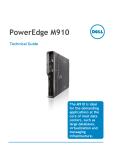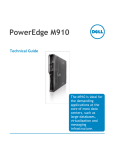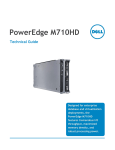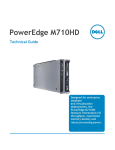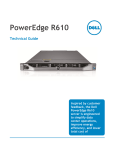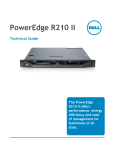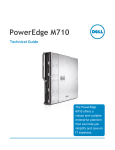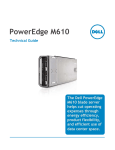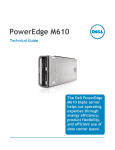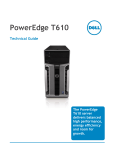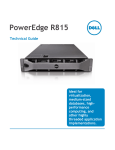Download Dell PowerEdge M915 System information
Transcript
PowerEdge M915 Technical Guide Maximized performance and bandwidth for mission-critical workloads and applications. Dell This document is for informational purposes only. Dell reserves the right to make changes without further notice to any products herein. The content provided is as is and without express or implied warranties of any kind. Dell, PowerEdge, and Dell OpenManage are trademarks of Dell, Inc. AMD, AMD Opteron, AMD PowerNow!, CoolCore, and combinations thereof are trademarks of Advanced Micro Devices, Inc. Broadcom is a registered trademark of Broadcom Corporation and/or its affiliates in the United States, certain other countries and/or the EU. Brocade is a registered trademark of Brocade Communications Systems, Inc., in the United States and/or in other countries. Citrix is a registered trademark and XenServer is a trademark of Citrix Systems, Inc. and/or one or more of its subsidiaries, and may be registered in the United States Patent and Trademark Office and in other countries. Emulex is a registered trademark of Emulex Corporation. ENERGY STAR is a registered trademark of the U.S. Environmental Protection Agency. Intel and Xeon are registered trademarks of Intel Corporation in the U.S. and other countries. Linux is a registered trademark of Linus Torvalds. Matrox is a registered trademark of Matrox Electronic Systems Ltd. Mellanox is a registered trademark and ConnectX is a trademark of Mellanox Technologies, Inc. Microsoft, Windows, Windows Server, and BitLocker are either registered trademarks or trademarks of Microsoft Corporation in the United States and/or other countries. Novell and SUSE are registered trademarks of Novell, Inc., in the United States and other countries. QLogic is a registered trademark of QLogic Corporation. Red Hat is a registered trademark of Red Hat, Inc. in the United States and other countries. VMware and ESX are registered trademarks and vSphere and ESXi are trademarks of VMware, Inc. in the United States and/or other jurisdictions. Other trademarks and trade names may be used in this document to refer to either the entities claiming the marks and names or their products. Dell disclaims proprietary interest in the marks and names of others. ©Copyright 2011 Dell Inc. All rights reserved. Reproduction or translation of any part of this work beyond that permitted by U.S. copyright laws without the written permission of Dell Inc. is unlawful and strictly forbidden. August 2011 Initial Release PowerEdge M915 Technical Guide ii Dell Table of Contents 1 2 3 4 5 6 7 Product Comparison ........................................................................................... 6 1.1 Overview .................................................................................................. 6 1.2 Maximum Workload Performance ...................................................................... 6 1.3 Boost Business Performance ............................................................................ 6 1.4 Throughput, Throughput, Throughput ................................................................ 6 1.5 Enterprise-Class Manageability and Efficiency ....................................................... 6 1.6 Comparison ............................................................................................... 7 New Technologies ............................................................................................ 10 System Information .......................................................................................... 11 Mechanical .................................................................................................... 13 4.1 Chassis Description..................................................................................... 13 4.2 Dimensions and Weight ................................................................................ 13 4.3 Front View and Features .............................................................................. 14 4.4 Back View and Features ............................................................................... 15 4.5 Power Supply Indicators ............................................................................... 15 4.6 LED Indicators .......................................................................................... 15 4.7 Side View ................................................................................................ 16 4.8 Internal-Chassis View .................................................................................. 17 4.9 Rails and Cable Management ......................................................................... 17 4.10 Chassis View ............................................................................................ 18 4.11 Fans ...................................................................................................... 18 4.12 Cabling ................................................................................................... 18 4.13 Control Panel/LCD ..................................................................................... 18 4.14 Security .................................................................................................. 18 4.15 Cover Latch ............................................................................................. 19 4.16 TPM (Trusted Platform Module) ...................................................................... 19 4.17 Power Off Security ..................................................................................... 19 4.18 USB Key .................................................................................................. 19 4.19 Battery ................................................................................................... 19 4.20 Field Replaceable Units (FRU)........................................................................ 19 4.21 User Accessible Jumpers, Sockets, and Connectors ............................................... 19 Power, Thermal, Acoustic .................................................................................. 20 5.1 Power Supplies ......................................................................................... 20 5.2 Power Efficiency ....................................................................................... 20 5.3 Environmental Specifications......................................................................... 20 5.4 ENERGY STAR Compliance ............................................................................ 21 5.5 Thermal.................................................................................................. 21 5.6 Acoustics ................................................................................................ 22 Processors ..................................................................................................... 23 6.1 Overview ................................................................................................ 23 6.2 Features ................................................................................................. 23 6.3 Supported Processors .................................................................................. 24 6.4 Processor Configurations .............................................................................. 24 6.5 Processor Installation .................................................................................. 24 Memory ........................................................................................................ 25 7.1 Overview ................................................................................................ 25 7.2 DIMMs Supported ....................................................................................... 25 7.3 DIMM Slots ............................................................................................... 25 7.4 DIMM Population Guidelines .......................................................................... 25 PowerEdge M915 Technical Guide iii Dell 7.5 Memory Speed .......................................................................................... 7.6 Sparing ................................................................................................... 7.7 Mirroring ................................................................................................. 7.8 Memory Scrubbing...................................................................................... 8 Chipset ........................................................................................................ 8.1 Overview ................................................................................................ 8.2 AMD I/O Bridges ........................................................................................ 8.3 HyperTransport 3 (HT-3) .............................................................................. 8.4 SouthBridge Link Interface ........................................................................... 8.5 AMD SP5100 SouthBridge .............................................................................. 8.6 PCI Express Mezzanine Connectors .................................................................. 9 BIOS ............................................................................................................ 9.1 Overview ................................................................................................ 9.2 Supported ACPI States ................................................................................. 10 Embedded LAN on Motherboard (LOM).................................................................... 10.1 PCI Express Network Daughtercards ................................................................. 10.2 Broadcom BCM5709S ................................................................................... 10.3 Broadcom BCM57712 ................................................................................... 11 I/O Mezzanine Card Options ................................................................................ 11.1 Overview ................................................................................................ 11.2 Options .................................................................................................. 12 Storage ........................................................................................................ 12.1 Drives .................................................................................................... 12.2 Hard Disk Drive Carriers ............................................................................... 12.3 Empty Drive Bays ....................................................................................... 12.4 Diskless Configuration Support ....................................................................... 12.5 RAID Configurations .................................................................................... 12.6 Storage Controllers .................................................................................... 12.6.1 PERC H200 Modular .............................................................................. 12.6.2 PERC H700 Modular .............................................................................. 12.6.3 SATA Repeater .................................................................................... 12.7 Optical Drives ........................................................................................... 12.8 External Storage........................................................................................ 13 Video ........................................................................................................... 14 Rack Information ............................................................................................. 15 Operating Systems ........................................................................................... 16 Virtualization ................................................................................................. 16.1 Overview ................................................................................................ 16.2 Advanced Infrastructure Manager by Scalent ...................................................... 17 Systems Management ........................................................................................ 17.1 Overview ................................................................................................ 17.2 Server Management .................................................................................... 17.3 Embedded Server Management ...................................................................... 17.4 Dell Lifecycle Controller and Unified Server Configurator ....................................... 17.5 Integrated Dell Remote Access Controller.......................................................... 17.6 iDRAC6 Enterprise ...................................................................................... 17.7 iDRAC6 Enterprise with Virtual Flash (vFlash) Media ............................................. 17.8 Chassis Management Controller (CMC) .............................................................. 18 USB Peripherals .............................................................................................. Appendix A. Statement of Volatility .......................................................................... Appendix B. Certifications ..................................................................................... B 1. Regulatory Certifications ............................................................................. PowerEdge M915 Technical Guide iv 25 26 26 26 27 27 27 27 27 27 28 29 29 29 30 30 30 30 31 31 31 32 32 32 32 32 33 33 33 33 34 34 34 35 36 37 38 38 38 40 40 40 41 41 41 42 42 44 45 46 50 50 Dell B 2. Product Safety Certifications ......................................................................... B 3. Electromagnetic Compatibility ....................................................................... B 4. Ergonomics, Acoustics and Hygienics ............................................................... Appendix C. Industry Standards ............................................................................... 50 51 51 52 Tables Table Table Table Table Table Table Table Table Table Table Table Table Table Table Table Table Table Table 1. 2. 3. 4. 5. 6. 7. 8. 9. 10. 11. 12. 13. 14. 15. 16. 17. 18. PowerEdge M915 Comparison to M910, R815, and R910 ......................................... 7 Product Features Summary ........................................................................ 11 Environmental Specifications ...................................................................... 20 Acoustical Performance of M1000e Chassis with Four M915 Blades Installed .............. 22 AMD Opteron Series 6100 Processors ............................................................. 23 Supported Processors ............................................................................... 24 Supported Hard Drives.............................................................................. 32 Factory RAID Configurations ....................................................................... 33 Supported Storage Controllers .................................................................... 33 Supported Video Modes ............................................................................ 35 Virtualization Software ............................................................................. 38 Unified Server Configurator Features and Description......................................... 41 Features List for Base Management Functionality, iDRAC, and vFlash Media .............. 42 Volatility.............................................................................................. 46 Product Safety Certifications ...................................................................... 50 Electromagnetic Compatibility Certifications ................................................... 51 Ergonomics, Acoustics and Hygienics............................................................. 51 Industry Standards .................................................................................. 52 Figures Figure Figure Figure Figure Figure Figure 1. 2. 3. 4. 5. 6. Front View ........................................................................................... Back View ............................................................................................ Side View ............................................................................................. Internal Chassis View ............................................................................... M1000e Chassis ...................................................................................... 2.5‖ Hard Drive Carrier ............................................................................ PowerEdge M915 Technical Guide v 14 15 16 17 18 32 Dell 1 Product Comparison 1.1 Overview The Dell™ PowerEdge™ M915 is a 4-socket full-height blade server ideal for mission-critical applications needing maximum I/O scalability and performance. 1.2 Maximum Workload Performance Input, process, analyze and report data on the same platform; consolidate servers; and scale during peak workloads. With up to 48 processor cores, the Dell PowerEdge™ M915 offers you the performance you need to run your important business applications and workloads. Get the ability to run robust virtual machines (VMs), maximize the number of virtual machines being run per server, and reap all the benefits of consolidation. The M915 can also help increase database performance by taking advantage of the high processor core count to run more tasks simultaneously. 1.3 Boost Business Performance The PowerEdge M915 offers robust AMD processors designed to: Deliver up to 48 processor cores for optimal 4-socket performance with 2-socket value and provide the essential features needed to operate your consolidated infrastructure efficiently. Give you the ability to monitor power and thermals at the processor level and assist with platform efficiency. Offer vast pools of processor cores to be deployed, which is ideal for assignment to virtualized servers. A fully loaded M1000e chassis with eight PowerEdge M915 blade servers running 12-core AMD Opteron™ 6100 series processors can yield up to 384 processor cores per chassis or 38 cores per U. 1.4 Throughput, Throughput, Throughput Unleash the potential of your consolidated VMs with more I/O throughput: Maximizing both 10GbE and GbE port counts provides your virtualized applications the dedicated bandwidth they need in I/O-intensive environments. Enabling the choice of fabric and vendor can enhance your flexibility to adopt and deploy networks at your own pace. Using up to six dual-port 10GbE network cards can bring the total aggregate throughput into a single server to an amazing 120 Gbps. An integrated, flexible network daughter-card enables a choice of embedded network adapters. Select either GbE network interface cards (NICs) or 10Gb converged network adapters (CNAs) to attach to M1000e I/O modules, such as the PowerConnect M8428-k converged network switch. I/O traffic can then flow to your existing Dell or 3rd-party switching infrastructure. 1.5 Enterprise-Class Manageability and Efficiency Spend more time creating business value and less on planning, deploying and managing IT. Spend less money keeping the lights on and cooling servers, reclaiming more resources for strategic business needs. One-to-many updating: The Chassis Management Controller and Lifecycle Controller simplify the update process for BIOS, firmware and drivers on a one-to-many basis without additional PowerEdge M915 Technical Guide 6 Dell software. Multi-chassis management provides one console access to several blade enclosures. Industry leading power and cooling: Efficient power supplies (fully redundant up to 92+%) utilize minimal power without compromising productivity. High-efficiency fans and intuitive chassis airflow ducting drive enterprise-class power consumption draw. Enterprise-Class High-Availability: Dual optional failsafe embedded hypervisors and hard drive fault tolerance through the hardware RAID controller (PERC) offer data-protective redundancy that safeguards your organization from IT loss or corruption. 1.6 Comparison Table 1. PowerEdge M915 Comparison to M910, R815, and R910 Feature M910 M915 R815 R910 AMD Opteron™ 6100 series processors AMD Opteron™ 6100 series processors Processor Intel® Xeon® E7-2800, E74800 and E7-8800 product family or Intel Xeon processor 6500 and 7500 series Intel® Xeon® E7-4800 and E7-8800 product family Intel Xeon processor 7500 series Front Side Bus Intel QuickPath Interconnect (QPI) HyperTransport3 (HT-3) HyperTransport3 (HT-3) Intel QuickPath Interconnect (QPI) Sockets 4 4 4 4 Cores 6, 8, or 10 8 or 12 8 or 12 6, 8, or 10 L3 Cache 30MB 12MB 12MB 30MB Intel 7500 AMD SR5670 and SP5100 AMD SR5650, SR5670, and SP5100 Intel 7500 DIMMs 32 DDR3 32 DDR3 32 DDR3 64 DDR3 Min/Max RAM 4GB/1TB 8GB/512GB 8GB/512GB 4GB/2TB Form Factor Full-height blade, dual-slot Full-height blade, dual-slot 2U rack 4U rack Drive Bays 2 x 2.5‖ hot-plug 2 x 2.5‖ hot-plug 6 x 2.5‖ hot-plug 16 x 2.5‖ hot-plug SAS SSD, SATA SSD, SAS, nearline SAS SATA SSD, SAS Hard Drive Types SAS SSD, SATA SSD, SAS, nearline SAS, SATA SATA SSD, SAS, nearline SAS, SATA Embedded Hard Drive Controller PERC H200 PERC H700 PERC 6/i PERC H200 PERC H700 PERC H200 PERC H700 PERC H200 PERC H700 Chipset PowerEdge M915 Technical Guide 7 Dell Feature M910 M915 R815 R910 Optional Hard Drive Controller PERC H200 PERC H700 PERC 6/i PERC H200 PERC H700 PERC H200 PERC H700 PERC H200 PERC H700 Availability Hot-plug hard drives Hot-plug redundant power and cooling ECC memory Single Device Data Correction (SDDC) Support for memory demand and patrol scrubbing High availability failover cluster support Hot-plug hard drives Hot-plug redundant power and cooling ECC memory Single Device Data Correction (SDDC) Support for memory demand and patrol scrubbing High availability failover cluster support Hot-plug hard drives Hot-plug redundant power and cooling ECC memory Single Device Data Correction (SDDC) Support for memory demand and patrol scrubbing High availability failover cluster support Hot-plug hard drives Hot-plug redundant power and cooling ECC memory Single Device Data Correction (SDDC) Support for memory demand and patrol scrubbing High availability failover cluster support Server Management iDRAC6 Enterprise, BMC, IPMI 2.0, Dell™ OpenManage™, Chassis Management Controller Optional: vFlash media iDRAC6 Enterprise, BMC, IPMI 2.0, Dell™ OpenManage™, Chassis Management Controller Optional: vFlash media iDRAC6 Express, BMC, IPMI 2.0, Dell™ OpenManage™ Optional: iDRAC6 Enterprise, vFlash media iDRAC6 Express, BMC, IPMI 2.0, Dell™ OpenManage™ Optional: iDRAC6 Enterprise, vFlash media Four x8 PCIe mezzanine slots Four x8 PCIe mezzanine slots Five x8 PCIe slots (three with x16 connectors) One x4 PCIe slot (x8 connector) One x4 storage slot (x8 connector) Standard: 7 PCIe slots (two x4, four x8, one x16) Optional: 10 PCIe (six x4, four x8) Mezzanine/ PCI Slots PowerEdge M915 Technical Guide 8 Dell Feature M910 M915 R815 R910 4 x 1GbE LOMs Broadcom® BCM5709S 4 x 1GbE LOMs Broadcom® BCM5709S or 2 x 10GbE Broadcom BCM57712 4 x 1GbE LOMs Broadcom® BCM5709C 1GbE or 10Gb Embedded NIC Options: 4-port (4 x 1GbE) Embedded NIC Broadcom® 5709C, or 4-port (2 x 10Gb SFP+ and 2 x 1GbE) Embedded NIC Broadcom 57711 + Broadcom 5709c Optional: various NICs available 2 front, 1 internal 2 front, 1 internal 2 front, 4 back, 1 internal 2 front, 2 back, 1 internal See M1000e Technical Guide See M1000e Technical Guide 2 x 1100W 4 x 750W (Energy Smart) or 4 x 1100W (high-output) See M1000e Technical Guide See M1000e Technical Guide 2U rack 4U rack NIC/LOM USB Power Supplies Form Factor PowerEdge M915 Technical Guide 9 Dell 2 New Technologies The Dell™ PowerEdge™ M915 features AMD Opteron™ 6100 series processors, designed specifically for high-end server applications, DDR3 memory, DIMM thermal sensors, PCI Express Generation 2, an internal redundant SD module, and iDRAC6 Enterprise. The Opteron 6100 series features up to twelve-core processing to maximize performance and performance/watt for data-center infrastructures and highly dense deployments. The processor also features the AMD Opteron micro-architecture and AMD64 architecture for flexibility in 64-bit and 32bit applications and operating systems. PowerEdge M915 Technical Guide 10 Dell 3 System Information For the latest information on supported features for the Dell™ PowerEdge™ M915, visit Dell.com. Table 2. Product Features Summary Feature Technical Specification Processors AMD Opteron™ 6100 series processors Chipset AMD (SR5670 and SP5100) Memory1 Up to 512GB1 (32 DIMM slots): 1GB/2GB/4GB/8GB/16GB DDR3 up to 1333MHz Drive Bays Up to two 2.5‖ SSD or SAS hot-plug drives Storage1 Hot-plug Hard Drive Options: 2.5‖ SATA SSD, SAS (15K, 10K) Maximum Internal Storage: Up to 2TB1 per blade External Storage: For information about Dell external storage options, visit Dell.com/Storage. RAID Controller Options PERC H200 (6Gb/s) PERC H700 (6Gb/s) with 512MB battery-backed cache; 512MB, 1GB non-volatile battery-backed cache I/O Mezzanine Card Options Fully populated mezzanine card slots and switch modules which yield 3 highly available, redundant I/O fabrics per blade. Ethernet: Dual-Port Broadcom® Gb Ethernet with TOE (BCM-5709S) Dual-Port Intel® 10Gb Ethernet Dual-Port Broadcom 10Gb Ethernet (BCM-57711) 10Gb Enhanced Ethernet: Dual-Port Intel®10Gb Enhanced Ethernet (10Gb Enhanced Ethernet—FCoE Ready) Dual-Port QLogic® CNA QME8142 (10Gb Enhanced Ethernet + FCoE) Brocade® BR1741M-k Dual-Port Mezzanine CNA Fibre Channel: Dual-Port QLogic FC8 Fibre Channel Host Bus Adapter (HBA) (QME2572) Dual-Port Emulex® FC8 Fibre Channel Host Bus Adapter (HBA) (LPe1205-M) Emulex 8 or 4 Gb/s Fibre Channel Pass-Through Module Infiniband: Dual-Port Mellanox® ConnectX Quad Data Rate (QDR) InfiniBand PowerEdge M915 Technical Guide 11 Dell Operating Systems Microsoft® Windows Server® 2008 SP2, x86/x64 (x64 includes Hyper-V™) Microsoft Windows Server 2008 R2 SP1, x64 (includes Hyper-V™ v2) Microsoft Windows® HPC Server 2008 Novell® SUSE® Linux® Enterprise Server Red Hat® Enterprise Linux Virtualization Options: Citrix® XenServer™ Microsoft Hyper-V™ through Microsoft Windows Server 2008 VMware® vSphere™ 4.1 (including VMware ESX® 4.1 or VMware ESXi™ 4.1) For more information on the specific versions and additions, visit Dell.com/OSsupport. Featured Database Applications Microsoft SQL Server® solutions (see Dell.com/SQL) Oracle® database solutions (see Dell.com/Oracle) Power Supply Supplied by Dell™ PowerEdge™ M1000e Blade Chassis Video Integrated Matrox® G200eW with 8MB memory Remote Management iDRAC6 Enterprise (standard) Systems Management BMC, IPMI 2.0 compliant Dell OpenManage™ Unified Server Configurator Lifecycle Controller iDRAC6 Enterprise with optional vFlash media Chassis Management Controller Embedded Hypervisor Optional dual-media redundant hypervisor 1 GB means 1 billion bytes and TB equals 1 trillion bytes; actual capacity varies with preloaded material and operating environment and will be less. For more information about the Dell blade solution, see the PowerEdge M1000e Technical Guide or the M1000e Blade Chassis Specification Sheet. PowerEdge M915 Technical Guide 12 Dell 4 Mechanical 4.1 Chassis Description The Dell™ PowerEdge™ M915 is a full-height blade server that requires an M1000e chassis to operate. It occupies 2 slots in the M1000e rack chassis for a maximum of 8 blades in one M1000e chassis. It can be mixed with other existing Dell blades and is designed to mix with possible future half-heightdouble-wide and full-height-double-wide blades. Some highlights include: Support for RAID Support for persistent storage (internal USB connector and two SD card slots) Refer to the PowerEdge M1000e Technical Guide for more information. 4.2 Dimensions and Weight The PowerEdge M915 dimensions and weight are listed as follows: Height: 38.5 cm (15.2 in) Width: 5 cm (2 in) Depth: 48.6 cm (19.2 in) Weight: (maximum configuration) 12.7 kg (28 lb) PowerEdge M915 Technical Guide 13 Dell 4.3 Front View and Features Figure 1 shows the front view of the M915. Figure 1. Front View See the Blade Features section in the About Your System chapter of the Dell PowerEdge Modular Systems Hardware Owner's Manual on Support.Dell.com for more information. PowerEdge M915 Technical Guide 14 Dell 4.4 Back View and Features Figure 2 shows the back view of the M915. Figure 2. Back View See the Blade Features section in the About Your System chapter of the Dell PowerEdge Modular Systems Hardware Owner's Manual on Support.Dell.com for more information. 4.5 Power Supply Indicators The power supplies must be connected to a power distribution unit (PDU), and not directly to an electrical outlet. The power supplies require a 200V–240V power source. See the Power Supply Indicators section in the About Your System chapter of the Dell PowerEdge Modular Systems Hardware Owner's Manual on Support.Dell.com for more information. 4.6 LED Indicators Each disk drive carrier has two LED indicators visible from the front of the system. One is a green LED for disk activity and the other is a bicolor (Green/Amber) LED for status information. The activity LED is driven by the disk drive during normal operation. The bicolor LED is controlled by the SEP device on the backplane. Both LEDs are used to indicate certain conditions under direction of a storage controller. PowerEdge M915 Technical Guide 15 Dell 4.7 Side View Figure 3 shows the side view of the M915. Figure 3. PowerEdge M915 Technical Guide Side View 16 Dell 4.8 Internal-Chassis View Figure 4 shows the internal-chassis view of the M915. Figure 4. Internal Chassis View 4.9 Rails and Cable Management See the PowerEdge M1000e Technical Guide. PowerEdge M915 Technical Guide 17 Dell 4.10 Chassis View Figure 5 shows the M915 mounted in the PowerEdge M1000e chassis. Figure 5. M1000e Chassis 4.11 Fans For detailed information, see the Dell PowerEdge Modular Systems Hardware Owner’s Manual on Support.Dell.com. 4.12 Cabling For detailed information, see the Dell PowerEdge Modular Systems Hardware Owner’s Manual or the Rack Installation Guide on Support.Dell.com. 4.13 Control Panel/LCD For detailed information, see the Dell PowerEdge Modular Systems Hardware Owner’s Manual on Support.Dell.com. 4.14 Security The M915 offers a configurable client IP address range for clients connecting to iDRAC6. For additional information regarding the PowerEdge M915 security features, see the Dell PowerEdge Modular Systems Hardware Owner’s Manual on Support.Dell.com. PowerEdge M915 Technical Guide 18 Dell 4.15 Cover Latch The blade module includes a latch for the cover. See the Opening and Closing the Blade section in the Installing Blade Components chapter in the Dell PowerEdge Modular Systems Hardware Owner’s Manual on Support.Dell.com for more information. 4.16 TPM (Trusted Platform Module) The TPM is used to generate/store keys, protect/authenticate passwords, and create/store digital certificates. TPM can also be used to enable the BitLocker™ hard drive encryption feature in Microsoft® Windows Server® 2008. TPM is enabled through a BIOS option and uses HMAC-SHA1-160 for binding. TCM is available in China. 4.17 Power Off Security Through the CMC, the front blade server USB ports and power button can be disabled so as to not allow any control of the system from the front of the blade. 4.18 USB Key The M915 provides an internal USB connector for a USB flash memory key. The USB memory key can be used as a boot device, security key, or mass storage device. 4.19 Battery A replaceable coin cell CR2032 3V battery is mounted on the planar to provide backup power for the Real-Time Clock and CMOS RAM. 4.20 Field Replaceable Units (FRU) The planar contains a serial EEPROM to contain FRU information including Dell part number, part revision level, and serial number. 4.21 User Accessible Jumpers, Sockets, and Connectors For information, see the System Board Information chapter in the Dell PowerEdge Modular Systems Hardware Owner’s Manual on Support.Dell.com. PowerEdge M915 Technical Guide 19 Dell 5 Power, Thermal, Acoustic 5.1 Power Supplies See the PowerEdge M1000e Technical Guide for information on power supplies and power supply specifications. 5.2 Power Efficiency One of the main features of blade servers is enhanced power efficiency. The M915 achieves higher power efficiency by implementing the following features: User-configurable power options with the M1000e Chassis Management Controller (CMC) (see M1000e documentation online at Support.Dell.com for further details) Improved power budgeting VR efficiency improvements (using switching regulators instead of linear regulators) Closed-loop thermal throttling Use of LV DDR3 memory (lower voltage compared to DDR2) BIOS Power/Performance options page Active Power Controller (BIOS-based CPU P-state manager) Ability to throttle memory Ability to disable a processor core Ability to turn off embedded NICs or PCIe lanes when not being used Energy Smart components at the M1000e chassis level to selectively enable more computing performance with less power consumption. 5.3 Environmental Specifications Table 3. Environmental Specifications Temperature Operating 10°C to 35°C (50°F to 95°F) with a maximum temperature gradation of 10°C per hour Note: For altitudes above 2950 feet, the maximum operating temperature is derated 1oF/500ft Storage -40°C to 65°C (-40°F to 149°F) with a maximum temperature gradation of 20°C per hour Relative Humidity Operating 20% to 80% (noncondensing) with a maximum humidity gradation of 10% per hour Storage 5% to 95% (noncondensing) with a maximum humidity gradation of 10% per hour Maximum Vibration Operating 0.26Grms at 5-350Hz in operational orientations Storage 1.54Grms at 10-250Hz in all orientations Maximum Shock Operating PowerEdge M915 Technical Guide Half sine shock in all operational orientations of 31G +/- 5% with a pulse duration of 2.6ms +/- 10% 20 Dell Half sine shock on all six sides of 71G +/- 5% with a pulse duration of 2ms +/- 10% Storage Altitude Operating -15.2m to 3048m (-50 to 10,000ft) Note: For altitudes above 2950ft, the maximum temperature is derated 1°F/550ft Storage -16 to 10,600m (-50 to 35,000ft) Maximum Vibration Operating 0.26Grms at 5-350Hz in operational orientations Storage 1.54Grms at 10-250Hz in all orientations Maximum Shock Operating Half sine shock in all operational orientations of 31G +/- 5% with a pulse duration of 2.6ms +/- 10% Storage Half sine shock on all six sides of 71G +/- 5% with a pulse duration of 2ms +/- 10% 5.4 ENERGY STAR Compliance ENERGY STAR® qualified configurations can be accessed from the ENERGY STAR Compliance results landing page on Dell.com. 5.5 Thermal The Dell™ PowerEdge™ M915 is the first blade to support ≥130W processors in a 4-socket configuration. Larger heat sinks provide increased cooling capability which enables 4-socket 140W configurations without restrictions on external ambient temperature. The M915 thermal solution includes the following features: Optimized airflow impedance for individual blade and chassis-level airflow balancing Custom top cover air baffling prevents DIMM airflow bypass to balance airflow and maintain proper DIMM cooling Custom-designed heat sinks maintain processor and chipset temperatures within thermal design targets Highly optimized fan control algorithm: o Base fan speeds are a function of hardware configuration and ambient temperature to minimize airflow for a given environment o PID fan control algorithms are used for processors, DIMMs, and NDC I/O thermal sensors to maintain appropriate thermal margin while minimizing component overcooling o NDC I/O sensor algorithm allows for lower fan speeds by sensing the air temperature near the exhaust of the blade while maintaining proper airflow and cooling for the mezzanine cards PowerEdge M915 Technical Guide 21 Dell o The highest fan-speed request from the above algorithms is used to set the appropriate fan speed for the blade o The ambient and hardware configuration sets the minimum fan speed—other algorithms increase fan speed as needed to maintain proper cooling 5.6 Acoustics Table 4 shows the acoustical performance for a typical configuration of the M1000e chassis with four PowerEdge M915 blade servers installed. Acoustical performance varies with hardware configurations. Table 4. Acoustical Performance of M1000e Chassis with Four M915 Blades Installed Typical Configuration (per blade) @ 23±2°C Ambient in M1000e Chassis Processors 4 x AMD 6174 (115W) Hard Drives 2 x 2.5‖ SAS (15K) 146GB DIMMs 8 x 8GB Mezzanine Cards 4 Operating Mode LwA-UL (bels) Standby 7.1 Idle 8.4 Processor Active 8.4 Definitions Standby: AC Power is connected to power supplies but the system is not turned on. Idle: Reference ISO7779 (1999) definition 3.1.7; system is running in its OS but no other specific activity. Processor Active: An operating mode per ISO7779 (1999) definition 3.1.6; a program is run to simulate utilization of processor in general applications. LwA–UL: The upper limit sound power level (LwA) calculated per section 4.4.2 of ISO 9296 (1988) and measured in accordance to ISO 7779 (1999). PowerEdge M915 Technical Guide 22 Dell 6 Processors 6.1 Overview The AMD Opteron™ 6100 series processors (G34) are designed specifically for high-end server applications. The G34 processor features up to twelve-core processing to maximize performance and performance/watt for datacenter infrastructures and highly dense deployments. The processor also features AMD Opteron micro-architecture and AMD64 architecture for flexibility in 64-bit and 32-bit applications and operating systems. The G34 processor utilizes a 1944-contact Organic Land Grid Array (OLGA) package that plugs into a surface mount socket (Socket-G34). The Dell™ PowerEdge™ M915 provides support for two and four G34 processors. Table 5. AMD Opteron Series 6100 Processors G34 Processor Cache size Features L1 L1 L2 L3 128K/core 128K/core 512K/core 12MB Multi-processor support 1–4 processors Package OLGA 1944 6.2 Features Key features of the G34 processor include: Up to twelve cores per processor (two dies per processor package) Four point-to-point HyperTransport (HT3) links at 6.4 GT/s (@ 3.2 GHz) 1944-pin OLGA(Organic Land Grid Array) package 45 nm process technology Up to 24MB shared L3 cache No termination required for non-populated CPUs (must populate CPU socket 1 first) Two integrated DDR3 memory controllers Compatible with existing x86 code base Instruction sets like MMX, SSE, SSE2, SSE3, 3DNow!, AMD64 Support for HT Assist Enhanced AMD-V™ and IOMMU Technology for virtualization support Enhanced AMD power efficiency features: o Enhanced AMD PowerNow!™ o CoolCore™ Technology o Hardware Thermal Control (HTC) Demand-based switching for active CPU power management as well as support for ACPI PStates and C-States o C1E support o Cool Speed BIOS allows the user to disable or enable processor cores. The cores will remain as defined after a reboot. PowerEdge M915 Technical Guide 23 Dell 6.3 Supported Processors For the latest information on supported processors for the PowerEdge M915, visit Dell.com. Table 6. Supported Processors Model Speed Power Cache Cores 6180SE 2.5GHz 140W 12MB 12 6176 2.3GHz 115W 12MB 12 6174 2.2GHz 115W 12MB 12 6172 2.1GHz 115W 12MB 12 6168 1.9GHz 115W 12MB 12 6166HE 1.8GHz 85W 12MB 12 6164HE 1.7GHz 85W 12MB 12 6140 2.6GHz 115W 12MB 8 6136 2.4GHz 115W 12MB 8 6134 2.3GHz 115W 12MB 8 6128 2.0GHz 115W 12MB 8 6132HE 2.2GHz 85W 12MB 8 6128HE 2.0GHz 85W 12MB 8 6124HE 1.8GHz 85W 12MB 8 6.4 Processor Configurations The PowerEdge M915 supports four G34 sockets with two- and four-processor configurations (85W, 115W, and 140W). A single processor can be used to boot for diagnostic purposes. 6.5 Processor Installation See the Processors section in the Installing Blade Components chapter in the Dell PowerEdge Modular Systems Hardware Owner’s Manual on Support.Dell.com. PowerEdge M915 Technical Guide 24 Dell 7 Memory 7.1 Overview The Dell™ PowerEdge™ M915 utilizes DDR3 memory, providing a high performance, high-speed memory interface capable of low latency response and high throughput. The platform supports Registered ECC DDR3L DIMMs (LV RDIMM). The M915 memory system supports up to 32 DIMMs. 7.2 DIMMs Supported The M915 memory interface uses 1 GB, 2 GB, 4 GB, 8 GB, and 16 GB DIMMs. UDIMMs are not supported. 7.3 DIMM Slots The M915 has 32 DIMM slots, organized in four channels per processor. The first DIMM slot in each channel is color-coded with white ejection tabs for ease of installation. The DIMM sockets are placed 400 mils (11mm) apart, center-to-center in order to provide enough space for sufficient airflow to cool stacked DIMMs. 7.4 DIMM Population Guidelines The DDR3 memory interface consists of 4 memory channels per processor socket. Each channel supports up to two LV RDIMMs for single/dual/quad rank. Each channel is capable of supporting up to two DDR3 memory modules. For optimal performance, the following memory configuration rules should be observed: Memory modules must be installed in pairs, beginning with the first two sockets in each set of memory modules. These sockets are marked by white retention levers. The memory configuration for each processor must be identical. Memory modules must be identical in size, speed, and technology in corresponding slots. If quad-rank memory modules are mixed with single- or dual-rank modules, the quad-rank modules must be installed in the sockets with the white release levers. If pairs of memory modules of different sizes are installed, the larger capacity memory modules must be in the lower numbered slots. DIMMs must be installed in each channel starting with the DIMM farthest from the processor (DIMM 1). Population order is identified by the silkscreen designator and the System Information Label (SIL) located on the chassis cover. System performance can be affected if memory configurations do not conform to the preceding installation guidelines. The system may issue an error message during start-up that the configuration is non-optimal. 7.5 Memory Speed The memory frequency is determined by a variety of inputs: Each processor has 4 DDR3 channels capable of supporting speeds up to 1333 MHz. Single-rank, dual-rank, and mixed single- and dual-rank DIMM types can support speeds up to 1333 MHz. PowerEdge M915 Technical Guide 25 Dell Quad-rank DIMM types can support speeds up to 1066 MHz. If DIMMs of different speeds are mixed, all channels will operate at the fastest common frequency. 7.6 Sparing Memory sparing (spare bank) is supported in certain configurations with 32 memory modules installed. If online sparing is enabled, identical DIMMs must be installed in the same slots across each channel. The memory sparing feature must be enabled in the Memory Information screen in the System Setup programs. To use memory sparing, node interleaving must be disabled. For more information on memory sparing, see the System Memory section in the Installing Blade Components chapter in the Dell PowerEdge Modular Systems Hardware Owner’s Manual on Support.Dell.com. 7.7 Mirroring Memory mirroring is not supported. 7.8 Memory Scrubbing The M915 memory interface supports memory scrubbing (sequential or redirection) and patrol scrubbing, single-bit correction, and multi-bit error detection. The failure of an x4 DRAM device results in errors to one ECC symbol and can be corrected (chipkill). The failure of an x8 DRAM device results in errors to two ECC symbols, and can be detected but cannot be corrected. PowerEdge M915 Technical Guide 26 Dell 8 Chipset 8.1 Overview The Dell™ PowerEdge™ M915 chipset has a dual I/O Bridge (IOB) configuration with AMD SR5670 IO bridges and the SP5100 Southbridge. The SR5670 is designed to support AMD’s G34 processor family, HyperTransport 3 Interface (2.6 GHz), DDR3 memory technology, and PCI Express Generation 2. 8.2 AMD I/O Bridges The PowerEdge M915 I/O Board uses two AMD SR5670 IOBs to provide links between the G34 processor(s) and I/O components. The main components of the I/O controllers are configured to use two x16 HyperTransport 3 link (to CPU1 and CPU2), up to 52 lanes of PCI Express Gen 2, a x4 PCIe Gen 1 Southbridge Interface (SB Link) and an integrated IOAPIC. CPU1 has direct HT3 link to IOB1 and CPU2 has direct HT3 link to IOB2. IOB1 has the Southbridge interface. 8.3 HyperTransport 3 (HT-3) The HyperTransport 3 (HT-3) consists of serial point-to-point interconnects for the processors and the I/O bridges. PowerEdge M915 has a total of four HT-3 links per processor which allows interconnecting each processor and an option for I/O bridge. Each I/O bridge has a single x16 HT-3 link. A full Link consists of 16 lanes (full-width) in each direction with a link speed of 6.4 GT/s. The HT-3 clocking for CPU HT-3 and IOB HT-3 are 3.2GHz and 2.6GHz, respectively. Therefore, the IOB HT-3 link is capable of 5.2 GT/s. For routing, the HT-3 links are grouped by x8 Command Address (CAD), x1 Control (CTL), and x1 Clock (CLK) for each RX and TX directions. 8.4 SouthBridge Link Interface The SB Link connects the SR5670 IOB with the AMD Southbridge SP5100. The SB Link (A-Link Express) is equivalent to an x4 PCI-e Gen 1 link with a transfer rate of 1 GB/s in each direction. 8.5 AMD SP5100 SouthBridge The AMD SP5100 is a highly integrated Southbridge controller, supporting the following functions: PCI Bus 32-bit Interface Rev 2.3 running at 33 MHz Serial ATA (SATA) ports with transfer rates up to 300 MB/s Five OHC (full-speed 1.1) and two EHCI (high-speed 2.0) USB host controllers, with up to 12 USB general purpose ports and 2 USB embedded ports. (The PowerEdge M915 uses eight of these ports for internal and external use from the general purpose ports.) Power management interface (ACPI 3.0b compliant) Integrated Micro Controller (IMC) and thermal management. (The iDRAC interfaces the Hardware Thermal Control [HTC] on PowerEdge M915, not the SP5100.) I/O interrupt controller SMBus 2.0 controller Low Pin Count (LPC) interface to Super I/O, Trusted Platform Module (TPM), and SPI-VU Serial Peripheral Interface (SPI) support for up to two devices (A 4 MB BIOS flash is connected to the SP5100 using SPI interface.) PowerEdge M915 Technical Guide 27 Dell 8.6 PCI Express Mezzanine Connectors The M915 supports four PCI Express Gen 2 x8 mezzanine connectors. The M915 does not support quad-port Gb Ethernet mezzanine cards because the M915 mezzanine cannot be bifurcated into two x4 PCIe lanes. PowerEdge M915 Technical Guide 28 Dell 9 BIOS 9.1 Overview The M915 BIOS is based on the Dell BIOS core, and supports the following features: G34 support Simultaneous Multi-Threading (SMT) support PCI 2.3 compliant Plug-and-play 1.0a compliant MP (Multiprocessor) 1.4 compliant Ability to boot from hard drive, optical drive, iSCSI drive, USB key, and SD card ACPI support PXE and WOL support for on-board NICs Memory sparing support SETUP access through <F2> key at end of POST USB 2.0 (USB boot code is 1.1 compliant) F1/F2 error logging in CMOS Virtual KVM, CD, and floppy support Unified Server Configurator (UEFI 2.1) support Power management support, including DBS, Power Inventory and multiple Power Profiles The PowerEdge M915 BIOS does not support the following: BIOS language localization BIOS recovery after bad flash 9.2 Supported ACPI States Supported ACPI system states include S0, S4 (OS), and S5. The M915 supports the standard ACPI states (see ACPI.info). PowerEdge M915 Technical Guide 29 Dell 10 Embedded LAN on Motherboard (LOM) 10.1 PCI Express Network Daughtercards The Dell™ PowerEdge™ M915 is designed to support two network daughtercards: 2 x 1GbE dual Broadcom® BCM5709S 2 x 10GbE Broadcom BCM57712 10.2 Broadcom BCM5709S The embedded Broadcom BCM5709S dual-port LAN controllers are located on the M915 network daughtercard. The following features are supported: x4 PCI Express Gen-2 capable interface Integrated MAC and PHY 3072x18 Byte context memory 64 KB receive buffer TCP Offload Engine (TOE) iSCSI Offload Engine (iSOE) Network Controller-Sideband Interface (NC-SI) connection for Flex Addressing Wake-On-LAN (WOL) PXE 2.0 remote boot iSCSI boot IPv4 and IPv6 support Bare-metal deployment support 10.3 Broadcom BCM57712 A Broadcom BCM57712 C-NIC powers the Broadcom 2 x 10GbE network daughtercard and supports TOE, iSOE, and Fiber Channel over Ethernet (FCoE). The following additional features are supported: X8 PCI Express Gen-2 host interface Broadcom BCM8073 KR PHY for 10GbE and GbE connectivity DCB support NC-SI connection for Flex Addressing Wake-On-LAN (WOL) PXE 2.1 remote boot iSCSI boot FCoE boot IPv4 and IPv6 support Bare-metal deployment support Optional PCI Partitioning providing 8 PFs SR-IOV Energy Efficient Ethernet support PowerEdge M915 Technical Guide 30 Dell 11 I/O Mezzanine Card Options 11.1 Overview The Dell™ PowerEdge™ M915 contains four PCIe Gen2 mezzanine slots. Installation of mezzanine cards requires an M1000e I/O Module (IOM) of the same fabric technology to be installed in the corresponding fabric slot of the mezzanine to support data flow through that fabric/slot. For more information, see the PowerEdge M1000e Technical Guide. 11.2 Options Available options for all 4 mezzanine slots include: Mellanox® QDR ConnectX™ Dual-Port Quad Data Rate (QDR) InfiniBand Broadcom® BCM57711 Dual Port KX4 MC (10G) Broadcom BCM5709S Dual Port SERDES Intel® Dual Port 10G KX4 MC Dual Port FC8 QLogic® QME2572 Dual Port FC8 Emulex® LPe1205-M QLogic CNA QME8142 (10Gb Enhanced Ethernet + FCoE) Emulex CNA OCM20102FM (10Gb Enhanced Ethernet) Intel 52599 (10Gb Enhanced Ethernet) The M915 does not support 4x1 (quad-port) Ethernet mezzanine cards. PowerEdge M915 Technical Guide 31 Dell 12 Storage 12.1 Drives The Dell™ PowerEdge™ M915 supports up to two 2.5‖ SSD or SAS hard disk drives. See Table 7 for information on supported hard drives. For the most up-to-date information on supported hard drives, visit Dell.com. Table 7. Supported Hard Drives Form Factor Capacity Speed Type 2.5‖ 50GB, 100GB N/A SATA SSD 2.5‖ 73GB, 146GB 15K SAS 2.5‖ 146GB, 300GB, 600GB, 900GB 10K SAS 12.2 Hard Disk Drive Carriers The M915 supports the Dell eleventh-generation 2.5‖ hard drive carrier (see Figure 6). Legacy carriers are not supported on the M915. Figure 6. 2.5” Hard Drive Carrier 12.3 Empty Drive Bays For the slots that are not occupied by drives, a carrier blank is provided to maintain proper cooling, maintain a uniform appearance to the unit, and provide EMI shielding. 12.4 Diskless Configuration Support The system supports diskless configuration with no storage controller (PERC H200 or PERC H700) installed in the system. A 2.5‖ HDD backplane is still installed in this configuration. PowerEdge M915 Technical Guide 32 Dell 12.5 RAID Configurations Table 8. Factory RAID Configurations Configuration Hot-plug Min. HD Max. HD Description ZERO No 0 0 Diskless configuration, no daughtercard ASSN No 1 2 SAS drives using PERC H200 with no RAID ASSR0 No 2 2 SAS drives using PERC H200 with drives in RAID 0 stripe ASSR1 Yes 2 2 SAS drives using PERC H200 with drives in RAID 1 mirror ASSCBR0 No 2 2 SAS or Solid State drives using the PERC H700 (with battery) with drives in RAID 0 stripe ASSCBR1 Yes 2 2 SAS or solid-state drives using PERC H700 (with battery) with drives in RAID 1 mirror 12.6 Storage Controllers Table 9. Supported Storage Controllers Model Interface Support PCI Support SAS Connectors Cache Memory Size Write Back Cache RAID Levels Max. Drive Support RAID Support PERC H700 Modular 6Gb/s SAS PCIExpress 2.0 1x4 internal 512MB Yes (battery backup) 0, 1, 5, 6, 10 4 Hardware RAID PERC H200 Modular 6Gb/s SAS PCIExpress 2.0 1x4 internal 0, 1, 10, supports non-RAID 4 Hardware RAID — — 12.6.1 PERC H200 Modular The PERC H200 Modular card is an expansion controller which incorporates two four-channel 6 Gb/s SAS IOCs for connection to SAS hard disk drives. It is designed in a form factor that allows the same card to be used in other 11G blade-server platforms. 12.6.2 PERC H700 Modular The M915 also supports the PERC H700 Modular storage controller card with battery-backed cache. The PERC H700 card has its own processor with a PCI Express Gen2 host interface and DDR2 memory. PowerEdge M915 Technical Guide 33 Dell 12.6.3 SATA Repeater The M915 does not support the SATA repeater. The only SATA drives supported by M915 are the SSD drives, which are only supported with a PERC solution. 12.7 Optical Drives Optical drives are optional in all M915 systems and connect to the blade through the front USB interface. The following internal slim-line drives are available on the M915: DVD-ROM DVD+RW PATA (IDE) optical drives are not supported. 12.8 External Storage A number of external storage options are available using the appropriate IOMs in the M1000e chassis and mezzanine card(s) in the M915 blade. See Dell.com/Storage for more information. PowerEdge M915 Technical Guide 34 Dell 13 Video The M915 Integrated Dell Remote Access Controller 6 (iDRAC6) incorporates an integrated video subsystem, connected to the 32-bit PCI interface of the AMD SP5100. This logic is based on the Matrox® G200. The device only supports 2D graphics. The integrated video core shares its video memory with the iDRAC6 128 MB DDR2 application space memory. This memory is also used for the KVM buffer. The M915 system supports the 2D graphics video modes shown in Table 10. Table 10. Supported Video Modes Resolution Refresh Rate (Hz) Color Depth (bit) 640 x 480 60, 72, 75, 85 8, 16, 32 800 x 600 56, 60, 72, 75, 85 8, 16, 32 1024 x 768 60, 72, 75, 85 8, 16, 32 1152 x 864 75 8, 16, 32 1280 x 1024 60, 75, 85 8, 16 1280 x 1024 60 32 PowerEdge M915 Technical Guide 35 Dell 14 Rack Information For information on rack and cable accessories for the Dell™ PowerEdge™ M915, see the PowerEdge M1000e Technical Guide and the M1000e Rack and Cable Advisor Tool. PowerEdge M915 Technical Guide 36 Dell 15 Operating Systems The Dell™ PowerEdge™ M915 is designed to meet the Microsoft® WinLogo 3.0 design specifications. For the most up-to-date information, see the Operating System Support Matrix for Dell PowerEdge Systems on Dell.com. PowerEdge M915 Technical Guide 37 Dell 16 Virtualization 16.1 Overview Table 11 shows the supported and certified virtualization software for the Dell™ PowerEdge™ M915. Table 11. Virtualization Software Operating Systems ® ® Factory Install (FI) VMware ESX /ESXi™ 4.0 FI VMware ESX 4.0 Update 2 Non-Factory Install (NFI), Drop in Box (DIB) only VMware ESXi 4.0 Update 2 Embedded Edition FI VMware ESXi 4.0 Update 2 Installable Edition Download version (NFI, No DIB) VMware ESX 4.1 Update 1 NFI, DIB only VMware ESXi 4.1 Update 1 Embedded Edition FI VMware ESXi 4.0 Update 1 Installable Edition Download version (NFI, No DIB) Support.Dell.com has extensive information designed to help customers configure virtualization software with PowerEdge servers. The Dell Support site also has many blade-related virtualization documents, as well as a detailed list of the virtualization platforms that are supported by Dell OpenManage™. It is possible to order the M915 with an SD card that does not contain ESXi. 16.2 Advanced Infrastructure Manager by Scalent Dell Advanced Infrastructure Manager (AIM) allows IT organizations to manage networking, storage, and servers (as well as server workloads) that can be dynamically reconfigured and deployed to meet the changing needs of today’s data center environment. Specifically, AIM provides IT professionals the ability to: Combine new and existing networking, storage devices, and servers into a holistic computing solution that enables dynamic allocation of resources to meet application workload requirements. Manage physical and virtual resources with a single solution that includes the ability to move workloads seamlessly across hardware platforms for increased availability and scalability. Provide virtualization-like functionality to non-virtual (physical) servers, including automated failover, dynamic load balancing, and business continuity. PowerEdge M915 Technical Guide 38 Dell Integrate existing infrastructure (networking, storage devices, and servers) into an AIM solution to provide investment protection and extend the useful life of existing data center assets. Significantly decrease the amount of time and people required to deploy hardware and get applications up and running by providing a repeatable, scalable framework for hardware implementation using AIM. More information can be found at Dell.com/AIM. PowerEdge M915 Technical Guide 39 Dell 17 Systems Management 17.1 Overview Dell delivers open, comprehensive, and integrated solutions that help you reduce the complexity of managing disparate IT assets. Combining Dell™ PowerEdge™ servers with a wide selection of Dell developed systems management solutions gives you choice and flexibility, so you can simplify and save in IT environments of any size. To help you meet your server management demands, Dell offers Dell OpenManage™ systems management solutions for: • • • Deployment of one or many servers from a single console Monitoring of server and storage health and maintenance Update of system, operating system, and application software Dell offers IT management solutions for organizations of all sizes—priced and sized appropriately, and supported comprehensively. 17.2 Server Management A Dell Systems Management and Documentation DVD and a Dell Management Console DVD are included with the product. ISO images are also available. A brief description of available content: • Dell Systems Build and Update Utility (SBUU): Dell Systems Build and Update Utility assists in OS install and pre-OS hardware configuration and updates. • Server Update Utility (SUU): This DVD has an inventory tool for managing updates to firmware, BIOS, and drivers for either Linux® or Microsoft® Windows® varieties. • OpenManage Server Administrator (OMSA): The OpenManage Server Administrator tool provides a comprehensive, one-to-one (one console to one server) systems management solution, designed for system administrators to manage systems locally and remotely over a network. OMSA allows system administrators to focus on managing their entire network by providing comprehensive one-to-one systems management. • Management Console: Dell IT Assistant (ITA) is also included, as well as tools to allow access to our remote management products. These tools are Remote Access Service for iDRAC and the Baseboard Management Controller (BMC) Utility. • Active Directory Snap-in Utility: The Active Directory Snap-in Utility provides an extension snap-in to the Microsoft Active Directory. This allows you to manage Dell specific Active Directory objects. The Dell-specific schema class definitions and their installation are also included on the DVD. • Dell Systems Service Diagnostics Tools: Dell Systems Service and Diagnostics tools deliver the latest Dell optimized drivers, utilities, and operating system-based diagnostics that you can use to update your system. • eDocs: The section includes PDF files for PowerEdge systems, storage peripherals, and Dell OpenManage™ software. • Dell Management Console (DMC): The Dell Management Console is a systems management console that enables systems administrators to discover and inventory devices on your network. It provides functions such as health and performance monitoring of networked devices, and patch management capabilities for Dell systems. DMC differs from the IT Assistant management console (described above) in that with DMC, value-add plug-ins that enable advanced functionality can be purchased and added to the base DMC product. PowerEdge M915 Technical Guide 40 Dell 17.3 Embedded Server Management The PowerEdge M915 implements circuitry for the next generation of Embedded Server Management. It is Intelligent Platform Management Interface (IPMI) v2.0 compliant. The iDRAC (Integrated Dell Remote Access Controller) is responsible for acting as an interface between the host system and its management software and the periphery devices. iDRAC6 provides features for managing the server remotely or in data center lights-out environments. Advanced iDRAC features require the installation of the optional iDRAC6 Enterprise card. 17.4 Dell Lifecycle Controller and Unified Server Configurator Embedded management is comprised of interdependent pieces: • • • Dell Lifecycle Controller Unified Server Configurator iDRAC6 Dell Lifecycle Controller powers the embedded management features. It includes integrated and tamper-proof storage for system-management tools and enablement utilities (firmware, drivers, etc.). Lifecycle Controller enables pre-OS server deployment, OS installation, platform updates, platform configuration, and diagnostics capabilities. Dell Unified Server Configurator (USC) is a graphical user interface (GUI) that aids in local server provisioning in a pre-OS environment. To access the Unified Server Configurator, press the <F10> key within 10 seconds of the Dell logo appearance during the system boot process. Table 12 details current functionality enabled by the USC. Table 12. Unified Server Configurator Features and Description Feature Description Faster O/S Installation Drivers and the installation utility are embedded on system, so no need to scour Dell.com. Faster System Updates Integration with Dell support automatically directed to latest versions of the Unified Server Configurator, iDRAC, RAID, BIOS, NIC, and power supply. Update Rollback Ability to recover to previous ―known good state‖ for all updatable components. More Comprehensive Diagnostics Diagnostic utilities are embedded on system. Simplified Hardware Configuration Detects RAID controller and allows user to configure virtual disk and choose virtual disk as boot device, eliminating the need to launch a separate utility. Also provides configuration for iDRAC, BIOS, and NIC/LOM. 17.5 Integrated Dell Remote Access Controller The integrated Dell Remote Access Controller (iDRAC6) provides IT Administrators comprehensive yet straightforward management of remote servers, by delivering ―as if you are there‖ presence and control. iDRAC6 helps users to save time and money by eliminating travel to the remote server(s), PowerEdge M915 Technical Guide 41 Dell whether that server is located in a different room, a different building, a different city, or in a different country. iDRAC6 Enterprise is a standard feature on the M915, and Virtual Flash (vFlash) media is a purchasable option. 17.6 iDRAC6 Enterprise The iDRAC6 Enterprise card provides access to advanced iDRAC6 features. The iDRAC6 Enterprise connects directly to the M915 planar and is mounted parallel to the planar with stand-offs. Key features for the iDRAC6 Enterprise include: • • • • Scripting capability with Dell’s Racadm command-line Remote video, keyboard, and mouse control with Virtual Console Remote media access with Virtual Media Dedicated network interface 17.7 iDRAC6 Enterprise with Virtual Flash (vFlash) Media The iDRAC6 Enterprise can be upgraded by adding the vFlash media card. This is an 8 GB Dellbranded SD card that enables a persistent 256 MB virtual flash partition. The vFlash media delivers the following key features: Support for 8 GB SD storage media Can be used as a repository for a pre-OS image, eliminating the need to maintain a network infrastructure for OS deployment Can also be used for permanent diagnostics image for use after system failures, or permanent failsafe image for periodic configuration changes A more detailed feature list for base management functionality, iDRAC6 Enterprise, and vFlash media is shown in Table 13. Table 13. Features List for Base Management Functionality, iDRAC, and vFlash Media Feature Base Management Functionality iDRAC6 Enterprise vFlash Media Interface and Standards Support Web-based GUI SNMP WSMAN SMASH-CLP Racadm commandline IPMI 2.0 Conductivity Shared/Failover Network Modes IPv4 PowerEdge M915 Technical Guide 42 Dell Feature Base Management Functionality vFlash Media IPv6 Dynamic DNS Dedicated NIC VLAN Tagging iDRAC6 Enterprise Security and Authentication Role-based Authority Local Users Active Directory SSL Encryption Remote Management and Remediation Remote Firmware Update Server power control Serial-over-LAN (with proxy) Serial-over-LAN (no proxy) Power capping Last crash screen capture Boot capture Serial-over-LAN Virtual media Virtual console Virtual console sharing Virtual flash Monitoring Real-time Power Monitoring Real-time Power Graphing Historical Power Counters Sensor Monitoring and Alerting PowerEdge M915 Technical Guide 43 Dell Feature Base Management Functionality iDRAC6 Enterprise vFlash Media Logging Features RAC Log Trace Log System Event Log 17.8 Chassis Management Controller (CMC) See the PowerEdge M1000e Technical Guide. PowerEdge M915 Technical Guide 44 Dell 18 USB Peripherals The Dell™ PowerEdge™ M915 provides an internal USB connector for a USB flash memory key. The USB memory key can be used as a boot device, security key, or mass storage device. The M915 also supports an external USB DVD-ROM or DVD+RW. PowerEdge M915 Technical Guide 45 Dell Appendix A. Statement of Volatility The Dell™ PowerEdge™ M915 contains both volatile and non-volatile (NV) components. Volatile components lose their data immediately upon removal of power from the component. Non-volatile components continue to retain their data even after the power has been removed from the component. Components chosen as user-definable configuration options (those not soldered to the motherboard) are not included in the Statement of Volatility. Configuration option information (pertinent to options such as microprocessors, system memory, remote access controllers, and storage controllers) is available by component separately. The NV components detailed in Table 14 are present in the PowerEdge M915 server. Table 14. Volatility Server BIOS Memory Size: 4MB Type: [Flash PROM, EEPROM]: SPI Flash EEPROM Can user programs or operating system write data to it during normal operation? No Purpose? [boot code] There is boot code and application code. The code is vital to the system booting to the OS. Contains the BIOS code. How is data input to this memory? Flashed in the factory or using Dell flash utility. How is this memory write protected? Software write protected System FRU Size: 256Kb Type: [Flash PROM, EEPROM]: Serial I2C EEPROM, nonvolatile Can user programs or operating system write data to it during normal operation? Yes. A user can enter a username and password which will be stored in the chip. Purpose? [boot code] This chip stores some system configuration information (system type, board PPID information) How is data input to this memory? I2C bus from the iDRAC6 How is this memory write protected? Only the iDRAC6 can write to the chip Server CMOS (Complementary Metal-Oxide Semiconductor) Memory Size: 256 bytes Type: [Flash PROM, EEPROM]: CMOS Can user programs or operating system write data to it during normal operation? Using BIOS setup Purpose? [boot code] BIOS configurations How is data input to this memory? BIOS defaults, BIOS setup How is this memory write protected? NA PowerEdge M915 Technical Guide 46 Dell Remarks RTC is inside SP5100 south bridge chip. Jumper on motherboard can be used to reset to factory default settings. Network Daughter Card LOM Memory Size: 4Mb Type: [Flash PROM, EEPROM]: Flash Can user programs or operating system write data to it during normal operation? Yes, under software control. Purpose? [boot code] Contains LOM boot code and config data How is data input to this memory? Requires vendor provided firmware file and loader program used during factory assembly or possible field update. A system loaded with arbitrary data in firmware memory would not operate. How is this memory write protected? Software control. Network Daughter Card FRU and Temperature Sensor Size: 512bytes Type: [Flash PROM, EEPROM]: EEPROM Can user programs or operating system write data to it during normal operation? No Purpose? [boot code] Contains firmware for FRU and temperature sensor processing How is data input to this memory? Boot block is cable flashed only, FRU and temperature registers are accessed via iDRAC6 I2C. How is this memory write protected? Software control. H200 SRAM Size: 128K Bytes Type: [Flash PROM, EEPROM]: Serial RAM Can user programs or operating system write data to it during normal operation? No Does it retain data when powered off? Yes Purpose? [boot code] Storage configuration data How is data input to this memory? Host controller through SDRAM bus How is this memory write protected? Software write protected H200 Flash Size: 64Mb Type: [Flash PROM, EEPROM]: Flash Can user programs or operating system write data to it during normal operation? No PowerEdge M915 Technical Guide 47 Dell Does it retain data when powered off? Yes Purpose? [boot code] H200 Firmware How is data input to this memory? Host controller How is this memory write protected? Software write protected H200 EEPROM Size: 64KB Type: [Flash PROM, EEPROM]: EEPROM Can user programs or operating system write data to it during normal operation? Yes Does it retain data when powered off? Yes Purpose? [boot code] Store board manufacture information How is data input to this memory? I2C bus from iDRAC6 How is this memory write protected? Only the iDRAC6 can write to the chip Remarks EDID EEPROM Size: 2K Type: [Flash PROM, EEPROM]: EEPROM Can user programs or operating system write data to it during normal operation? no Does it retain data when powered off? Yes Purpose? [e.g. boot code] Stores current monitor information How is data input to this memory? I2C bus from iDRAC6 How is this memory write protected? no Server Video Memory Size: 64M x16 Type: [Flash PROM, EEPROM]: DDR2 SDRAM Can user programs or operating system write data to it during normal operation? Yes Purpose? [boot code] Graphics Buffer How is data input to this memory? Normal Operation How is this memory write protected? No CPLD Size: Master CPLD: 2280 logic elements; 7.5Kbits RAM; 27.6Kbits EBR SRAM Slave CPLD: 1200 logic elements: 6.25Kbits RAM; 9.2Kbits EBR SRAM Type: [Flash PROM, EEPROM]: Programmable Logic Device PowerEdge M915 Technical Guide 48 Dell Can user programs or operating system write data to it during normal operation? Yes (Customer can use DOS program to update CPLD image) Purpose? [boot code] Provide blade power sequencing and other blade control logic. How is data input to this memory? By way of specialized programming utilities used in the factory and possibly for field updates. How is this memory write protected? Software control. Remarks Two CPLDs: master and slave HDD Backplane Firmware (SEP) Memory Size: 32KB Type: [Flash PROM, EEPROM]: Flash Can user programs or operating system write data to it during normal operation? No. A special (not available to customers) DOS utility is needed to flash the application code, and the boot block is cable flashed only. Purpose? [boot code] Interface between the RAID controller and the hard drives as well as a controller for the HDD status LED. How is data input to this memory? Cable flash to flash entire chip or a special utility (not available to customers) to flash in DOS. How is this memory write protected? Software write protected. No hardware protection pin. iDRAC6 Enterprise SPI Flash Size: 2MB Type: [Flash PROM, EEPROM]: SPI Flash Can user programs or operating system write data to it during normal operation? No Purpose? [boot code] There is boot code that is used by the iDRAC6 Enterprise management controller. Also contains the Life Cycle Log which contains server management data unique to the run-time events of the server itself. How is data input to this memory? Flashed in the factory or using Dell flash utility. Also written to by the iDRAC6 Enterprise controller to make Life Cycle Log (LCL) entries. How is this memory write protected? Software write protected To obtain optional component information, please refer to the Dell Statement of Volatility for the individual components. Please direct any questions to your Dell Marketing contact. PowerEdge M915 Technical Guide 49 Dell Appendix B. Certifications B 1. Regulatory Certifications Regulatory compliance certificates can be located at the following sites: http://ausreactorprd01/reactor/xCertSearch.asp http://www.dell.com/content/topics/global.aspx/about_dell/values/regulatory_compliance /dec_conform?c=us&l=en&s=corp B 2. Product Safety Certifications The product has been certified and bears the Mark, as applicable, of the Product Safety authorities as indicated in Table 15. Table 15. Product Safety Certifications Country/Region Authority or Mark Argentina IRAM Belarus BELLIS Canada SCC China CNCA or CCC Croatia KONCAR European Union CE Germany TUV IECEE IECEE CB Israel SII Kazakhstan OTAN – CKT Kenya KEBS Kuwait KUCAS Mexico NYCE or NOM Moldova INSM Nigeria SONCAP Norway NEMKO Russia GOST Saudi Arabia KSA ICCP South Africa NRCS Taiwan BSMI Ukraine UKRTEST or UKRSERTCOMPUTER United States NRTL Uzbekistan STZ PowerEdge M915 Technical Guide 50 Dell B 3. Electromagnetic Compatibility The product has been certified and bears the Mark, as applicable, of the EMC authorities as indicated in Table 16. Table 16. Electromagnetic Compatibility Certifications Country/Region Authority or Mark Class Australia/New Zealand ACMA or C-Tick Belarus BELLIS Bosnia & Herzegovina, Montenegro, Serbia KVALITET Canada ICES Class A China CNCA or CCC Class A Croatia KONCAR Class A European Union CE Class A Israel SII Class A Japan VCCI Class A Kazakhstan OTAN – CKT Class A Moldova INSM Class A Norway NEMKO Class A Russia GOST Class A South Africa SABS Class A South Korea KCC Class A Taiwan BSMI Class A Ukraine UKRTEST or UKRSERTCOMPUTER Class A United States FCC Class A Uzbekistan STZ Class A Vietnam ICT Class A Class A Class A Class A B 4. Ergonomics, Acoustics and Hygienics The product has been certified and bears the Mark, as applicable, of the Ergonomics, Acoustics and Hygienics authorities as indicated in Table 17. Table 17. Ergonomics, Acoustics and Hygienics Country/Region Authority or Mark Belarus BELLIS Germany GS Russia GOST PowerEdge M915 Technical Guide 51 Dell Appendix C. Industry Standards The Dell™ PowerEdge™ M915 system conforms to the industry standards detailed in Table 18. Table 18. Industry Standards Standard URL for Information and Specifications ACPI Advance Configuration and Power Interface Specification, v2.0c http://www.acpi.info/ Energy Star EPA Version 1.0 of the Computer Server specification http://www.energystar.gov/index.cfm?c=archives.enterprise _servers Ethernet IEEE 802.3-2005 http://standards.ieee.org/getieee802/802.3.html IPMI Intelligent Platform Management Interface, v2.0 http://www.intel.com/design/servers/ipmi/ DDR3 Memory DDR3 SDRAM Specification, Rev. 3A http://www.jedec.org/download/search/JESD79-3A.pdf LPC Low Pin Count Interface Specification, Rev. 1.1 http://developer.AMD.com/design/chipsets/industry/lpc.ht m PCI Express PCI Express Base Specification Rev. 2.0 http://www.pcisig.com/specifications/pciexpress/ PMBus Power System Management Protocol Specification, v1.1 http://pmbus.info/specs.html SAS Serial Attached SCSI, v1.1 http://www.t10.org/cgi-bin/ac.pl?t=f&f=sas1r10.pdf SATA Serial ATA Rev. 2.6; SATA II, Extensions to SATA 1.0a, Rev. 1.2 http://sata-io.org/ SMBIOS System Management BIOS Reference Specification, v2.6 http://www.dmtf.org/standards/smbios/ TPM Trusted Platform Module Specification, v1.2 http://www.trustedcomputinggroup.org/resources/tpm_mai n_specification PowerEdge M915 Technical Guide 52 Dell Standard URL for Information and Specifications UEFI Unified Extensible Firmware Interface Specification, v2.1 http://www.uefi.org/specs/ USB Universal Serial Bus Specification, Rev. 2.0 http://www.usb.org/developers/docs/ Microsoft® Windows® Logo Windows Logo Program System and Device Requirements, v3.10 http://www.microsoft.com/whdc/winlogo/hwrequirements. mspx PowerEdge M915 Technical Guide 53





















































